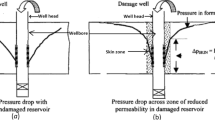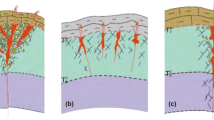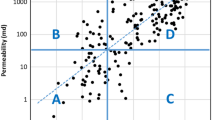Abstract
In order to improve the recovery of tight oil and extend the life cycle of the oilfield, in this paper, we have conducted a systematic study on the fine characterization of remaining oil distribution. A three-dimensional numerical simulation method was used to study remaining oil distribution of tight sandstones with the constraints of structure, sedimentary facies, and petrophysical properties. The results show that the distribution of remaining oil in the Chang 2 Member was affected by the structural location, sand body thickness, and petrophysical properties. The remaining oil saturation is higher in the axial parts of nose-like uplifts, the edge parts of thick sand bodies, and the positions where the monoclinic and sand bodies intersect; however, in the flanks of the nose-like uplifts, when the monoclinics are distributed nearly parallel the sand bodies, and in low-lying areas, a low oil saturation distribution often occurs. When two parameters in structure, sand body thickness, and petrophysical properties satisfy favorable conditions, this area is likely to become a favorable remaining oil enrichment area. Numerical simulation results show that improving the injection and production well pattern and increasing the number of oil production wells are important measures to improve oil recovery. The density of the well pattern can be considered as 30–50 wells per square kilometer.














Similar content being viewed by others

References
Abouzar M, Ghanbarian B (2021) A new methodology for grou** and averaging capillary pressure curves for reservoir models. Energy Geosci 2(1):52–62
Bai QH, Liu YQ, Fan TT (2009) Genesis and distribution of laumontite in Yanchang formation of upper Triassic in Ordos Basin. Northwest Geol 42(2):100–107
Bai YB, Zhao JZ, Fang ZQ, Liu P (2013) Forming mechanism of quasi-continuous tight sandstone reservoir of Chang 6 oil-bearing formation, Ordos Basin. Pet Geol Exp 35(1):65–71
Bu J (2010) Research on sedimentary facies and reservoir of Chang 2 Formation in Yu Jia** Area. Northwest University
Bukar M, Worden R, Bukar S, Shell P (2021) Diagenesis and its controls on reservoir quality of the Tambar oil field, Norwegian North Sea. Energy Geosci 2(1):10–31
Dong S, Zeng L, Lyu W, **a D, Liu G, Wu Y, Du X (2020) Fracture identification and evaluation using conventional logs in tight sandstones: A case study in the Ordos Basin. China Energy Geosci 1(3–4):115–123
Fu DK, Feng ZY, Qu JM, Deng SH, Wang EH (2007) Current situation and prospect of residual oil distribution forecast. Fault-Block Oil & Gas Field 14(2):39–41
Guo L, Wang YB, Liu WX, Zhang CL, Liu WL, Liu TH (2006) Variation law of reservoir parameters during water flooding in Dagang oil field. Petroleum Geology & Expeximent 28(1):85–90
He J, Feng SB, Huang J, Yuan XQ, Han P, Li TY (2008) Effects of provenance on porosity development of Chang 6 sandstone of the Yanchang formation in the Center of Ordos Basin. Acta Sedimentol Sin 29(1):80–87
Hong DD, Cao J, Wu T, Dang S, Hu W, Yao S (2020) Authigenic clay minerals and calcite dissolution influence reservoir quality in tight sandstones: Insights from the central Junggar Basin, NW China. Energy Geosci 1(1–2):8–19
Huang SJ, Liu J, Shen LC, Wu WH (2001) Reservoir configuration features of narrow thin sand body and its influence in remaining oil distribution. Geol Rev 47(3):301–308
Huang YG, Chen ZQ, Wignall PB, Grasby SE, Zhao LS, Wang XD, Kaiho K (2019) Biotic responses to volatile volcanism and environmental stresses over the Guadalupian-Lo**ian (Permian) transition. Geology 47:175–178
Jiang HQ, Yao J, Jiang RZ (2006) Reservoir engineering principles and methods. The second edition. Dongying. China University of Petroleum Press 1–298
Kirmani F, Raza A, Gholami R, Haidar M, Fareed C (2021) Analyzing the effect of steam quality and injection temperature on the performance of steam flooding. Energy Geosci 2(1):83–86
Li HZ (2014). Fine evaluation of low permeability reservoirs in Yanchang Formation in Zichang, Ordos Basin. Northwest University
Li H, Wang FR, Dai SL, Fan H (2008) Influence of chlorite film on reservoir porosity: a case study from the second member of Yanchang formation in Ordos Basin. Lithologic Reservoirs 20(4):71–74
Li SH, Fang GQ, Yang JL, Liao JB, Fan JM (2012) Origin of ultra-low permeability reservoirs in Ordos Basin and its significance. Lithologic Reservoirs 24(6):32–37
Li AR, Wang WX, Wu FL, Zhao JZ, Zhang H (2013) Oil accumulation patterns of Chang 4+5 and Chang 6 in Yan’an delta, Ordos Basin. Oil Gas Geol 34(5):667–671
Li Y, Zhou DH, Wang WH, Jiang TX, Xue ZJ (2020) Development of unconventional gas and technologies adopted in China. Energy Geosci 1(1–2):55–68
Luo ZT, Wang YC (1986) Pore structure of oil and gas reservoir. Bei**g Science Press
Peng SM, Chen YQ (2013) Practical petroleum development geology and reservoir engineering method. Bei**g Petroleum Industry Press 1–494
Shi, Y.M., Huo, J., Zhang, Y.G., 2004. Fine description of reservoirs in middle and late stage of continental oilfield development. Bei**g: Petroleum Industry Press. 1–267
Sun TB, Lin CY, Tian M (2013) Reservoir configuration features of narrow thin sand body and its influence in remaining oil distribution. Mineral Petrol 33(2):94–101
Wang QZ (2005) Research on depositional systems and pool-forming assemblages of Chang 1 and Chang 2 Members of the Yanchang Formation from Ansai-Zichang area in the Ordos Basin. Northwest University
Wang W, Dong L, Tan C, Yin S, Li A, Wang R (2020) Developmental characteristics and dominant factors of fractures in marine–continental transitional facies tight sandstone reservoirs in heavily deformed areas: A case study. Arab J Geosci 13(3):1–20
Wu FL, Wang BY, Zhao JZ, Liu HB, Li GT, Chen MQ (2008) Origin and characteristics of oil pool sequence in Ordos Basin. Acta Pet Sin 29(5):639–643
Wu SQ, Chen ZQ, Fang YH, Pei Y, Yang H, Ogg J (2017) A Permian-Triassic boundary microbialite deposit from the eastern Yangtze platform (Jiangxi Province, South China): geobiologic features, ecosystem composition and redox conditions. Palaeogeogr Palaeoclimatol Palaeoecol 486:58–73
Xu GM, Xu HD, Kong XY (1999) AppliIcation of high-resolution sequence stratigraphy in reservoir numerical simulation. Oil Gas Geol 20(2):115–119
Xu L, Shi YM, Xu CS, Yang Y, Li H, Chai Z (2013) Influences of feldspars on the storage and permeability conditions in tight oil reservoirs: a case study of Chang-6 oil layer group, Ordos Basin. Pet Explor Dev 40(4):448–454
Yang Y (2009) Analysis on the influential factors of remaining oil distribution rules. Journal of Oil and Gas Technology 31(1):100–103
Yang XP, Qiu YN (2002) Formation process and distribution of lau-montite in Yanchang formation (upper Triassic) of Ordos Basin. Acta Sedimentol Sin 20(4):628–632
Yang H, Li SX, Liu XY (2010) Characteristics and resource prospects of tight oil and shale oil in Ordos Basin. Acta Pet Sin 34(1):1–11
Yao JL, Deng XQ, Zhao YD, Han TY, Chu MJ, Pang JL (2013) Characteristics of tight oil in Triassic Yanchang formation, Ordos Basin. Pet Explor Dev 40(2):150–158
Yin S, Wu Z (2020) Geomechanical simulation of low-order fracture of tight sandstone. Mar Pet Geol 100(7):1–15
Yin YS, Wu SH, Zhang SF, Yin TJ, Li SH (2005) Application of high resolution sequence stratigraphy in reservoir modeling of Shasan middle - middle - section in Huaicheng oilfield. Journal of Oil and Gas Technology 27(2):301–303
Yin S, Lv D, Ding W (2018) New method for assessing microfracture stress sensitivity in tight sandstone reservoirs based on acoustic experiments. Int J Geomec 18(4):1–16
Yin S, Han C, Wu Z, Li Q (2019) Developmental characteristics, influencing factors and prediction of fractures for a tight gas sandstone in a gentle structural area of the Ordos Basin, China. J Nat Gas Sci Eng 72(1–14):103032
Yin S, Dong L, Yang X, Wang R (2020) Experimental investigation of the petrophysical properties, minerals, elements and pore structures in tight sandstones. J Nat Gas Sci Eng 73(1–12)
Zeng LB, Hong T (2009) The key geological factors influencing on development of low-permeability sandstone reservoirs: a case study of the Taizhao area in the Songliao Basin, China. Energy Explor Exploit 27(6):425–437
Zeng DQ, Zhang SM, Lu LZ (2003) Types and characteristics of fractures in tight sandstone gas reservoirs with low permeability. Acta Pet Sin 24(4, 36):–39
Zhang SN, Ding XQ (2010) Characters and causes of tight sandstones of Yanchang formation in southern Ordos Basin, China. Journal of Chengdu University of Technology (Science & Technology Edition) 37(4):386–394
Zhang, S.Y., Lan, J.Y.,2013. Establishment of underwater distributary channel structure model and control of remaining oil. Reservoir Evaluation and Development 3(5), 9–12
Zhao JY, Luo JL, Lei XL, Guo DY, Wang YD, Fan WH, **a HP (2007) Provenance analysis of the sixth member of the Yanchang formation in the Yangjiayuanze oil prospect area, Zichang oilfield, Ordos basin. Geol China 34(3):422–429
Zheng R, Liu LY, Li NX, Liu XC (2011) Reservoir diagenesis and pore evolution of Chang 4+5 of Yangchang formation in Shaanbei Zichang area. Journal of Northwest University (Natural Science Edition) 41(5):848–852
Zou CN, Zhu RK, Chen ZQ, Ogg JG, Wu ST, Dong DZ, Qiu Z, Wang YM, Wang L, Lin SH, Cui JW, Su L, Yang Z (2019) Organic-matter-rich shales of China. Earth Sci Rev 189:51–78
Funding
This research was supported by the National Natural Science Foundation of China (Grant No. 41772140).
Author information
Authors and Affiliations
Corresponding authors
Additional information
Responsible Editor: Zeynal Abiddin Erguler
About this article
Cite this article
Li, A., Qiang, Q., Yin, S. et al. Numerical simulation of remaining oil distribution in tight sandstone reservoirs: a case study of the upper Triassic Yanchang formation in the Ordos Basin, China. Arab J Geosci 14, 31 (2021). https://doi.org/10.1007/s12517-020-06325-3
Received:
Accepted:
Published:
DOI: https://doi.org/10.1007/s12517-020-06325-3



